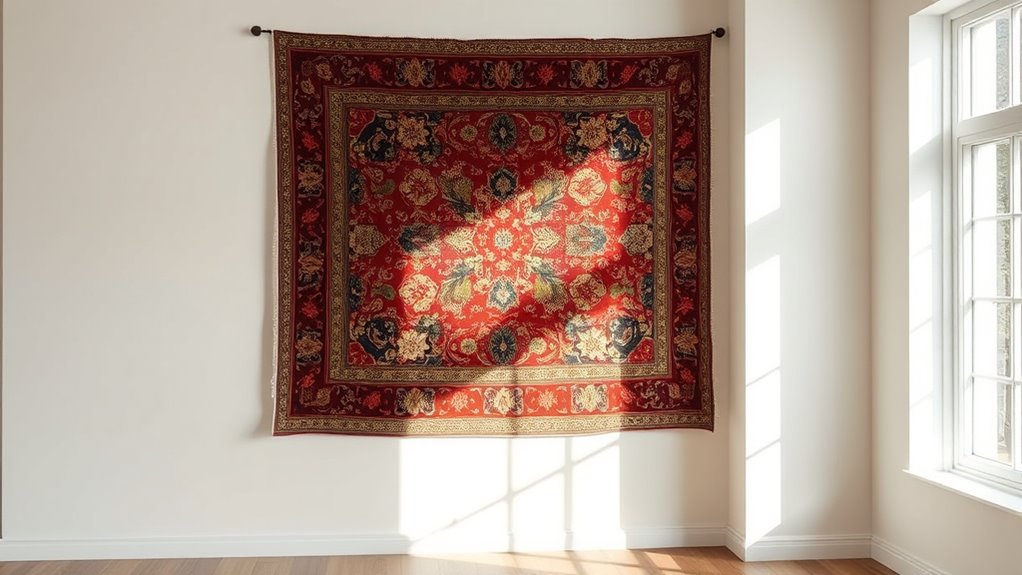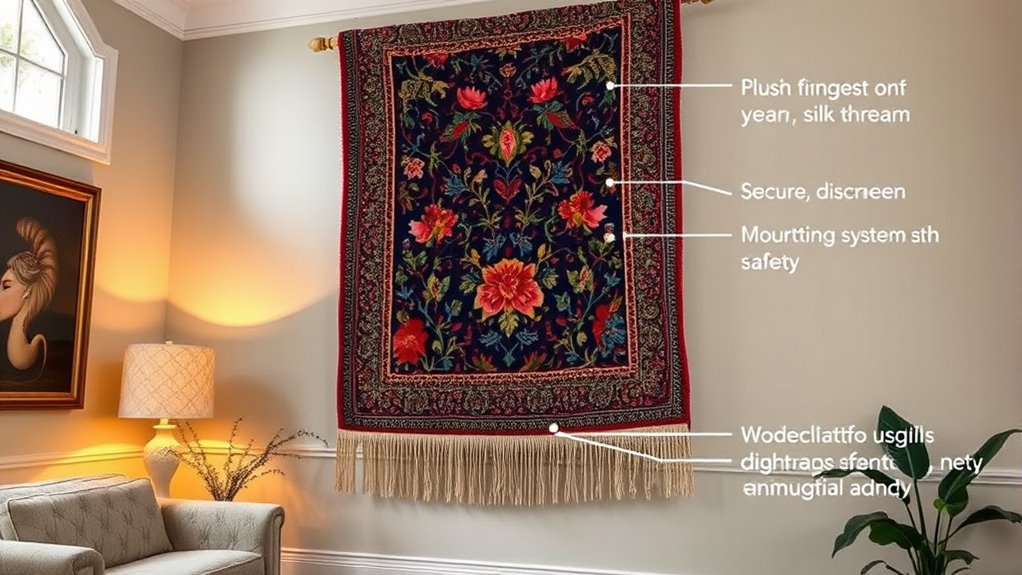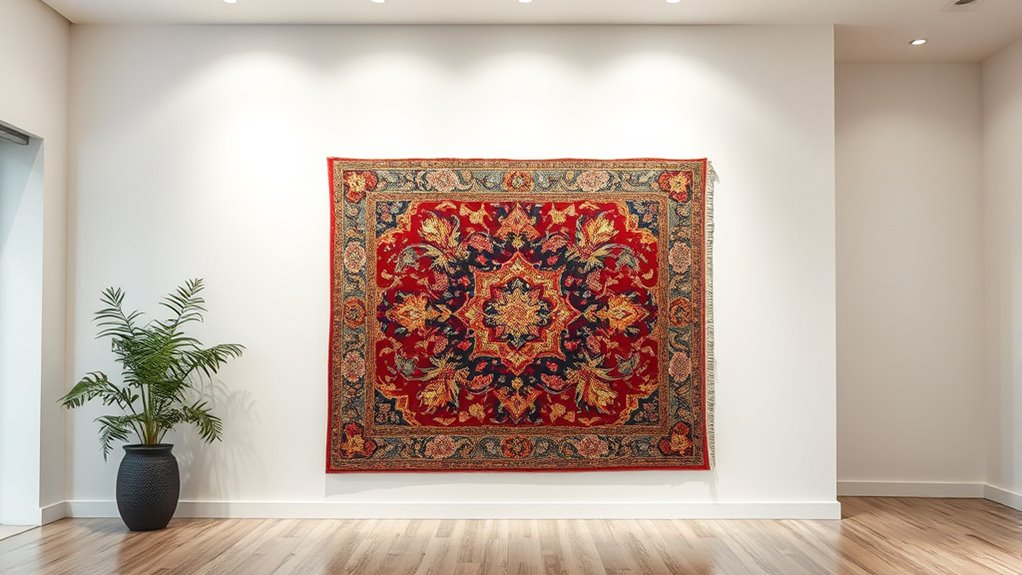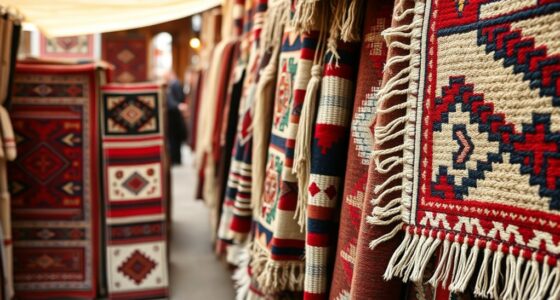To use antique rugs as wall hangings safely, start by choosing a piece that’s in good condition and suits your space’s style and size. Prepare your wall by making sure it’s sturdy and clean, and select secure hardware like D-rings or anchors suitable for the rug’s weight. Handle the rug carefully, avoid direct sunlight, and check periodically for damage. Keep these tips in mind, and you’ll guarantee your art stays beautiful and protected—that’s just the beginning.
Key Takeaways
- Ensure wall stability and proper wall material assessment before hanging antique rugs.
- Select appropriate hardware like anchors or French cleats based on rug weight and wall type.
- Handle rugs with care, using gloves and gentle cleaning to prevent damage during installation.
- Protect rugs from direct sunlight, heat, and humidity to preserve fibers and colors.
- Regularly inspect and maintain hanging hardware and rug condition to prevent accidents and deterioration.
Selecting the Right Antique Rug for Wall Display

Choosing the right antique rug for wall display begins with understanding its design, size, and condition. Analyzing the rug’s pattern and color palette helps guarantee it complements your space. You’ll want a piece with good craftsmanship and minimal damage, which may require expert antique restoration to preserve its beauty. Before hanging, consider rug cleaning to remove dust and dirt, enhancing its visual appeal and longevity. Pay attention to the rug’s size; a larger piece makes a bold statement, while a smaller one offers versatility. Always inspect for signs of fading, tears, or worn areas, and consult specialists if restoration is needed. Selecting a well-preserved, appropriately sized antique rug will ensure it remains a stunning wall feature for years to come. Additionally, understanding the rustic charm of antique textiles can help you appreciate their historical value and aesthetic appeal. Incorporating knowledge of 16PF traits can also assist in choosing a piece that resonates with your personal style and emotional connection to the textile. A comprehensive evaluation of the condition and authenticity of the rug will further help in making an informed decision for a safe and beautiful display.
Preparing Your Wall and Mounting Area

Before hanging your antique rug, it’s essential to properly prepare your wall and mounting area to guarantee a secure and visually appealing display. Start with wall preparation by inspecting the surface for stability, evenness, and cleanliness. Remove any nails, hooks, or loose paint that could interfere with a smooth mount. Conduct a mounting area assessment to identify the best spot—consider wall material, height, and lighting. Ensure the wall can support the weight of the rug without damage. Measure the space carefully to determine the ideal placement, keeping in mind the rug’s size and design. This preparation stage helps prevent future issues, ensuring your antique rug hangs securely and enhances your space beautifully. Proper setup is key to a safe, professional-looking display. Additionally, understanding mounting techniques and selecting appropriate hardware will further secure your rug and preserve your wall’s integrity. Using appropriate hardware can also help minimize potential damage to your wall over time. When selecting hardware, consider wall support to ensure it can bear the weight of your antique rug safely. To further ensure safety, consulting with a professional installer can provide expert guidance tailored to your specific wall type and rug weight.
Choosing Appropriate Hanging Methods and Hardware

When selecting the right hanging method and hardware for your antique rug, it’s important to contemplate both the weight of the piece and the wall material. For heavier rugs, opt for sturdy hardware options like picture hooks with anchors, French cleats, or steel D-rings. Light to medium-weight rugs can be safely hung with heavy-duty picture hangers or wall hooks designed to distribute weight evenly. If you have drywall, avoid nails alone and use anchors to prevent slipping or damage. For plaster or brick walls, toggle bolts or masonry anchors provide better support. Always consider weight considerations carefully to prevent accidents or damage. Using appropriate hardware ensures your antique rug stays securely displayed and retains its beauty over time. Proper hanging techniques also help in preserving the integrity of your rug and the wall surface. Additionally, understanding industry trends can help you choose the most effective hanging methods for your space. To further ensure safety, consider testing the support with gentle pressure before fully hanging the rug. Incorporating appropriate hardware is essential not only for security but also for maintaining the aesthetic quality of your display.
Handling and Maintaining Antique Rugs as Wall Art

Proper handling and regular maintenance are key to preserving the beauty of your antique rug displayed on the wall. To guarantee fiber preservation and maintain its aesthetic appeal, handle your rug with clean hands or gloves, avoiding unnecessary touching. Regularly dust or gently vacuum the surface using a soft brush attachment to prevent dust buildup without damaging delicate fibers. Rotate the rug periodically to distribute light exposure evenly and prevent fading. Additionally, keep the wall environment stable—avoid direct sunlight, humidity fluctuations, and extreme temperatures that can weaken fibers and compromise appearance.
Handle with care, dust regularly, rotate, and keep environment stable to preserve your antique wall rug.
- Use gentle cleaning methods suited for antique fibers
- Keep the rug away from direct sunlight and moisture
- Inspect periodically for signs of wear or damage
Ensuring Safety and Preventing Damage

To guarantee your antique rug remains safe and free from damage, you need to take proactive steps to protect it from potential hazards. Applying fire resistant finishes can reduce the risk of fire, providing an added safety layer. Additionally, UV protective coatings help prevent fading and deterioration caused by sunlight exposure. Ascertain your rug is hung away from direct sunlight, windows, or heat sources, and use appropriate mounting methods to avoid unnecessary stress on the fibers. Proper wall hanging techniques can prevent tearing or distortion of the rug’s structure. Regularly inspect the wall hanging for signs of wear or damage, and clean it gently to prevent dust buildup. Understanding the financial impact of collections like antique rugs can motivate proper preservation techniques. Incorporating creative practice into your maintenance routine—such as experimenting with different cleaning methods or display options—can lead to innovative ways to safeguard your investment. Paying attention to proper display techniques can further ensure your antique rug’s longevity and beauty. Combining these protective measures creates a safer environment for your antique rug, helping preserve its beauty and integrity for years to come.
Frequently Asked Questions
How Can I Tell if an Antique Rug Is Suitable for Wall Hanging?
To determine if an antique rug is suitable for wall hanging, start with a rug age assessment to gauge its durability and value. Check for material authenticity verification by inspecting the fibers and dyes—authentic antique rugs often have natural materials and dyes that age beautifully. Confirm the rug’s backing is stable, and consult a professional if needed. These steps help you confidently hang an antique rug safely and stylishly.
What Are the Best Ways to Prevent Irreversible Damage to Antique Rugs?
Oh sure, just toss your antique rug on the wall and hope it survives. Instead, you should embrace preservation techniques and environmental controls. Keep humidity steady, avoid direct sunlight, and guarantee proper hanging methods. Regularly inspect your piece for damage, and consider professional conservation advice. These steps protect your treasure from irreversible harm, allowing you to enjoy its beauty without turning it into a faded, fragile relic.
Are There Specific Cleaning Methods for Antique Rugs Used as Wall Art?
When cleaning antique rugs used as wall art, you should focus on gentle techniques to prevent damage. Use soft brushes or vacuum with a gentle suction setting, avoiding harsh chemicals. Preservation tips include avoiding direct sunlight and moisture, which can cause fading and deterioration. If needed, consult a professional textile conservator for deep cleaning. Always prioritize delicate handling and proper storage to preserve the rug’s beauty and value.
Can I Use Adhesives to Mount Antique Rugs on Walls Safely?
Did you know that improper mounting can damage antique rugs? You might consider adhesive options, but they can risk glue stains or fiber damage. Instead, explore mounting techniques like proper hooks or tension rods designed for delicate textiles. These methods hold your rug securely without adhesives, preserving its integrity. Using the right approach guarantees your antique rug stays beautiful and safe on your wall, avoiding unnecessary harm.
What Are Common Mistakes to Avoid When Hanging Antique Rugs?
When hanging antique rugs, you should avoid common mistakes like using improper framing or adhesives that cause rug fraying. Make sure you support the rug evenly to prevent stress on fragile fibers, and don’t hang it directly with nails or staples that could damage the delicate edges. Always handle the rug carefully, and opt for proper mounting methods to protect it from fraying and preserve its beauty.
Conclusion
By treating your antique rug like a treasured painting, you transform your space into a woven tapestry of history and art. With careful selection, proper preparation, and thoughtful hanging, you turn fragile threads into a sturdy statement. Remember, your wall isn’t just a backdrop—it’s a stage where timeless stories unfold. When you prioritize safety and preservation, your antique rug can gracefully dance between beauty and durability, becoming a mesmerizing centerpiece that whispers tales of the past.









